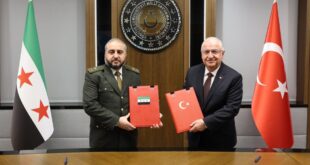BAGHDAD – The new commander of American forces in Baghdad plans to increase the number of local garrisons across the Iraqi capital even as U.S. troop levels drop in the coming months.
Moving soldiers out of relatively safe bases and into Baghdad’s dangerous streets was a key element in the counter- insurgency strategy implemented by the commander of U.S. forces, General David Petraeus, when he arrived a year ago.
The tactic has been vital to the U.S. military’s goal of not just clearing neighborhoods of militants but then holding them.
Major-General Jeffery Hammond told foreign journalists on Tuesday that he had a total of 75 joint security stations and combat outposts in Baghdad and planned to add another dozen of each from now until June.
U.S. forces live and operate with Iraqi forces in such garrisons.
“I’m extending our reach even further than what it is now to be less predictable and to push ourselves into locations where maybe in the past we didn’t go before,” Hammond said.
“I don’t want there to be any place in Baghdad where al Qaeda or anyone else can start to take hold because we’ve ignored that particular (area).”
Hammond said at least two joint security stations were being set up now in Baghdad where he believed there was an al Qaeda “nerve”. He declined to give the location.
The U.S. military calls Sunni Islamist al Qaeda the greatest threat to peace in Iraq. U.S. commanders have previously said there was no place in Baghdad where al Qaeda had a foothold.
Most of the 30,000 extra troops sent to Iraq last year were deployed in Baghdad, which was the epicenter of sectarian bloodletting between majority Shi’ites and minority Sunni Arabs in 2006 and early 2007.
Hammond, who assumed his post last month, described the change in the city’s security conditions as “remarkable”.
He acknowledged he would have fewer forces as U.S. troop numbers across Iraq fall by more than 20,000 through to the middle of the year under a plan endorsed by Petraeus following security gains. There are around 150,000 U.S. troops in Iraq.
“It will be less, which means I’ve got to do everything within my power to make the adjustments that are necessary on the ground to sustain security,” Hammond said, adding he was not sure how his troop numbers would change.
NEIGHBOURHOOD PATROLS
Another key factor behind better security in Iraq has been the creation of neighborhood patrols comprising around 80,000 men, most of whom get paid a monthly wage of about $300.
The U.S. military, which calls the men “concerned local citizens”, has always said deployment of such units would be temporary, with around 20 percent expected to join the Iraqi security forces and other jobs found for the rest.
Hammond said he would like to see the units scaled down over time as more security responsibility was picked up by local police, but added there would not be a hasty reduction.
“We are not going to make some of the mistakes that we have made in the past and that’s turning over too quickly any piece of Baghdad,” he said.
Asked about rising attacks against neighborhood patrols, which are mainly blamed on al Qaeda, Hammond said: “The big question is will the CLCs stand shoulder to shoulder … Right now, I see no indications whatsoever of the CLCs backing down.”
 Eurasia Press & News
Eurasia Press & News



